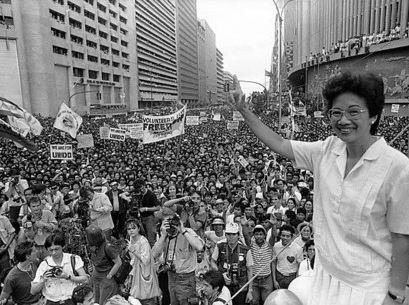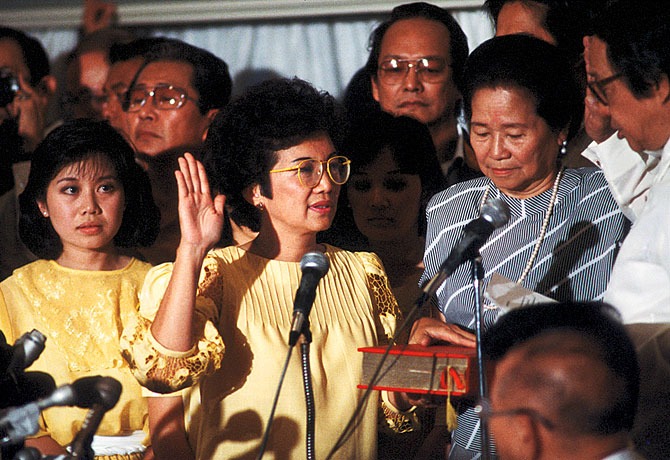Hundreds of thousands of Filipinos converged on Epifanio de los Santos Avenue from February 22 to 25, 1986, to protest President Ferdinand Marcos’ claim that he had won re-election against Corazon Aquino. This historical event is regarded as one of the most significant political occurrences of the 1980s.
What is the People Power Revolution?
The 1986 EDSA Revolution began in 1983 and ended on February 22, 1986. The tactics utilized amounted to a long-term civil resistance campaign against government brutality and election fraud. President Ferdinand Marcos was deposed, and the country’s democracy was restored due to this nonviolent revolution.
Due to the prevalence of yellow ribbons during the rallies following the death of Filipino senator Benigno Aquino, Jr., it is also known as the Yellow Revolution. It was primarily seen as a famous victory over then-president Ferdinand Marcos’ 20-year autocratic and oppressive government and made headlines as “the revolution that astonished the world.”
The large percent of the protests took place in Metro Manila along a long stretch of Epifanio de los Santos Avenue, or EDSA, and involved over two million Filipino civilians, as well as several political, military, and religious groups led by Cardinal Jaime Sin, Archbishop of Manila, and CBCP President Cardinal Ricardo Vidal, Archbishop of Cebu. The demonstrations resulted in Marcos’ flight from Malacanang Palace to Hawaii, spurred by resistance and criticism to his years of a corrupt administration. Following the revolution, Corazon Aquino was declared the rightful president of the Philippines. You can also find out the most popular tourist destinations in the Philippines here.
Background
The charges of rampant fraud and corruption dogged Ferdinand Marcos’ second presidential term. The growing wealth gap between the highly affluent and the very poor, who made up the bulk of the population, resulted in increased crime and civil instability throughout the country. These factors, as well as the formation of the New People’s Army, an armed revolt in the Philippines calling for wealth redistribution and land reform, and a bloody Muslim separatist movement led by the Moro National Liberation Front or MNLF in the southern island of Mindanao, contributed to the rapid rise of civil discontent and unrest in the Philippines.
Marcos was unable to compete for a third term as President in 1973; therefore, he imposed martial law on September 23, 1972, by presidential proclamation No. 1081, claiming growing civil disobedience as grounds. Marcos gained emergency powers with this proclamation, giving him complete control of the Philippine military and the right to repress freedom of speech, freedom of the press, and many other fundamental liberties. Marcos also disbanded the Philippine Congress and shut down media outlets that were critical of his administration.
Ferdinand Marcos established a dictatorship in the Philippines during his presidency, giving him absolute control over the military and national finances and a personality cult.
Several groups of people, including some within the government, plotted to topple Marcos during his reign. They were headed by jailed opposition senator Benigno “Ninoy” Aquino, Jr., a popular public figure Marcos accused of favoring a left-wing solution. While garnering popularity among Filipinos for his opposition to Marcos, Aquino was compelled to seek exile in the United States due to health and safety concerns.
On August 21, 1983, Benigno Aquino was killed while disembarking from a Taiwanese commercial flight at Manila International Airport, which was subsequently renamed in honor of a three-year exile in the United States.
Election and Snap Election
To legitimize his authority over the country, Marcos declared on November 3, 1985, that a presidential snap election would be held the following year, one year ahead of the usual presidential election schedule, due to pressure from Washington. The Marcos-controlled unicameral congress, the Regular Batasang Pambansa, passed Batas Pambansa Blg. 883, or National Law No. 883, which authorized the hasty election. Corazon Aquino, Ninoy Aquino’s widow, was urged by the rising opposition movement to run for President, with Salvador Laurel as her vice-presidential running partner. Marcos stood for re-election, and his running companion was Arturo Tolentino.
The Aquino-Laurel ticket was affiliated with the United Opposition (UNIDO), whereas the Marcos-Tolentino ticket was affiliated with the Kilusang Bagong Lipunan.
The Catholic Bishops’ Conference of the Philippines, led by Ricardo Cardinal Vidal, released a statement criticizing the elections following accusations of possible fraud. The same criticism was expressed in a resolution voted by the United States Senate. The fraud claims were described as “disturbing” by US President Ronald Reagan in a statement. In reaction to the demonstrations, the COMELEC declared Marcos the winner with 53 percent of the vote over Aquino.
COMELEC and Batasang Pambansa declared Marcos in the middle of the debate on February 15. In a show of defiance, all 50 opposition members of Parliament walked out. On the other hand, the Filipino people refused to recognize the findings, claiming that Aquino was the true victor. Both “victors” took their oaths of office in different locations, with Aquino receiving more popular votes. Aquino also called for a coordinated strike and a widespread boycott of Marcos’ cronies’ media and businesses. As a result, crony banks, firms, and the media took a beating, and their stock prices plunged to new lows.
Two Inaugurations were held
A minor skirmish between loyal government forces and reformists happened early Tuesday morning, February 25, about 7 a.m.
Corazon Aquino became the Philippine president in a modest ceremony at Club Filipino in Greenhills, approximately a kilometer from Camp Crame, later that morning. Senior Associate Justice Claudio Teehankee swore her in as President, while Justice Vicente Abad Santos swore her in as Vice-President. Aurora Aquino, Ninoy Aquino’s mother, carried the Bible on which Aquino took her oath. Ramos, who was later elevated to General, Enrile, and several politicians, were present.
Marcos staged his inauguration at Malacanang Palace an hour later. Loyalist civilians attended the event. Marcos took office on the Palace balcony, which was carried live on IBC-13 and GMA-7. For security concerns, none of the invited international dignitaries attended the ceremony.
Ferdinand Marcos’ departure
The Marcos family boarded an HH-3E Rescue chopper of the United States Air Force and traveled to Clark Air Base. The ousted First Family subsequently flew north of the United States territory of Guam aboard US Air Force DC-9 Medivac and C-141B planes before arriving at Hickam Air Force Base in Hawaii on February 26.
Many citizens celebrated and danced in the streets as word of the Marcos family’s departure reached them. Demonstrators stormed the Palace in Mendiola, which had been closed to the public for over a decade. Despite some theft by enraged protestors, the bulk of people strolled around inside. They were gazing at things both lavish and commonplace that the Marcos dynasty and its court had abandoned in their escape.
If you want to learn more facts about the Philippines such as the things you didn’t know about sports betting in the Philippines, visit the given link.



